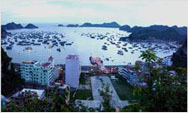You are here » Home » Telling Our Story
Case Study
Mango producers and exporters collaborate to enter U.S. market
Mango Farmers Become Entrepreneurs

| |
Photo: Chemonics/Leah Garcia
|
|
Employees of a mango-packing plant near Santo Domingo prepare mangos for export to the United States.
New post-harvest and packaging techniques improve quality of fresh mangos, allowing producers to access gourmet niche markets in Europe and expand exports to the U.S.
|
Challenge
Some of Latin America’s finest mangos are grown in the Dominican Republic. Yet for decades they were sold only domestically, often grown in backyards or abandoned plots, and exported only as an industrial pulp, selling at lower prices than fresh fruit. Although the U.S. market was nearby, the competition and regulations appeared too daunting to tackle. Mango farmers had no organized association, lacked a clear business strategy, and had little government support.
Initiative
In 2005, USAID helped create a mango “industry cluster,” bringing together farmers, suppliers, exporters, transport companies, and government bodies. USAID assisted them in gaining entry to the U.S. market, helping set goals and overcome obstacles. A major hurdle was meeting U.S. phytosanitary requirements and ensuring that all exports were pest-free. Since this required a lot of collaboration among all parties, similar efforts had failed before. USAID also introduced new pruning and packaging methods and worked closely with the U.S. agencies that provided final approval to import the mangos.
Results
Today, everyone involved in the nascent mango export industry is working together and their next goal is to expand to high-end niche markets. They’re no longer farmers or distributors; they’re entrepreneurs who are working jointly to develop a sector-wide business strategy and reduce costs. Also, private investors are investing in treatment facilities for mangos. Pruning techniques introduced by USAID are doubling yields, improving fruit quality and lowering costs. In 2005, they earned $2 million from exports to Europe and $300,000 from exports to the U.S. In 2006, they intend to double their U.S. sales. For the mango cluster, now known as PROMANGO, this is only the beginning.
Print-friendly version of this page (533kb - PDF)
Click here for high-res photo
Back to Top ^ | 

